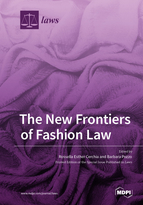The New Frontiers of Fashion Law
A special issue of Laws (ISSN 2075-471X).
Deadline for manuscript submissions: closed (30 June 2019) | Viewed by 231178
Special Issue Editors
Interests: contract law; comparative law; tort law; fashion law
Interests: comparative law; women’s rights in a comparative law perspective; environmental protection through private law; advertising law; legal translation
Special Issue Information
Dear Collegues,
Fashion law encompasses a wide variety of issues that concern an article of clothing or a fashion accessory, from the moment they have been designed, to their distribution, to the market.
Contract law, intellectual property, company law, tax law, international trade, and customs law are of fundamental importance in defining the new field of law that is gradually taking shape at various universities.
This Special Issue will focus on the new frontiers of fashion law, taking into account the various fields that recently showed up as being of great interest for the whole fashion world.
The scope of this Special Issue will range from sustainable fashion to wearable technologies, from the new remedies to cultural appropriation to the regulation of model weight, from advertising law on the digital market to the impact of new technologies on products distribution, taking into account recent trends in a comparative law perspective and trying to underline the newest international developments.
The purpose of this Special Issue is to stimulate discussion on emerging problems that might define new the boundaries of fashion law, while reaching out for new solutions that a comparative law perspective will render more interesting.
This Special Issue will, therefore, try to sketch out the new legal fields in which the fashion industry is getting involved, identifying the new boundaries of fashion law that existing literature has not dealt with in a comprehensive way.
Prof. Rossella Esther Cerchia
Prof. Barbara Pozzo
Guest Editors
Manuscript Submission Information
Manuscripts should be submitted online at www.mdpi.com by registering and logging in to this website. Once you are registered, click here to go to the submission form. Manuscripts can be submitted until the deadline. All submissions that pass pre-check are peer-reviewed. Accepted papers will be published continuously in the journal (as soon as accepted) and will be listed together on the special issue website. Research articles, review articles as well as short communications are invited. For planned papers, a title and short abstract (about 100 words) can be sent to the Editorial Office for announcement on this website.
Submitted manuscripts should not have been published previously, nor be under consideration for publication elsewhere (except conference proceedings papers). All manuscripts are thoroughly refereed through a double-blind peer-review process. A guide for authors and other relevant information for submission of manuscripts is available on the Instructions for Authors page. Laws is an international peer-reviewed open access semimonthly journal published by MDPI.
Please visit the Instructions for Authors page before submitting a manuscript. The Article Processing Charge (APC) for publication in this open access journal is 1400 CHF (Swiss Francs). Submitted papers should be well formatted and use good English. Authors may use MDPI's English editing service prior to publication or during author revisions.
Keywords
- Wearable technologies in the fashion world
- Blockchain, intellectual property and fashion law
- Textile wastes
- Sustainable fashion
- The protection of runways Remedies against cultural appropriation in the fashion business
- Digital market, bloggers and trendsetters: the new world of advertising law
- Photoshop and the (virtual) body of models






